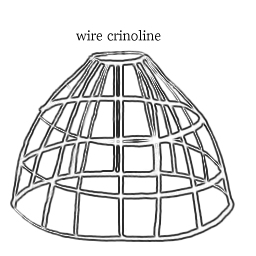crinoline
open-weave cotton fabric which is heavily sized to be used for stiffening a stiffened petticoat undergarment for a woman similar to a slip, but starting at the waist and worn to extend the skirt of a dress. the crinoline underskirt served to keep skirts full by means of stiff fabrics and numerous layers. It was fairly inexpensive, and therefore commoners and aristocrats alike could afford to wear it (though wealthy women could usually afford petticoats of finer material and of more elaborate design) In the 1830s a linen material woven with horsehair called crinoline was first used for cloth petticoats. The word crinoline comes from the French for 'crin' and 'lin', meaning horsehair and linen respectively. This version of a petticoat was the original crinoline and later the name continued in use incorrectly, but universally for the caged or hooped underskirt frames. Flounces and pleats continued to be added to the crinoline petticoat design as the fashion moved toward a very broad domed silhouette. As the decade progressed, more and more petticoats were added until the skirts were very full. For decency as well as fashion a minimum of six petticoats was considered essential. They became very heavy and unbearable in summer heat. At last in 1856 the cage crinoline petticoat or artificial crinoline was introduced. With this support, ladies had to wear just one petticoat to soften the cage ridges. Of course as gusts of wind often blew the crinolines sideways, long drawers became essential underwear. The American W. S. Thomson patented the metal cage crinoline in the USA, France and Britain in 1856. The crinoline knew no class differences and it was the first fashion to be adopted in England and America by all classes, even if the quality of the crinoline was doubtful the cheaper it got. Working women wore cheaper versions of the cage showing ugly ridges of steel bands. Women loved the cage crinoline. At the height of its popularity enough steel was produced in Sheffield to make half a million hoops in one week. Ladies were freed from the heavy petticoats that had begun to weigh them down and they were able to move their legs very freely beneath the cage. The cage crinoline could be awkward in wear and could cause damage to objects, knocking them with a swish in the wrong direction. Even so, it was a welcome alternative to restrictive petticoat layers.
